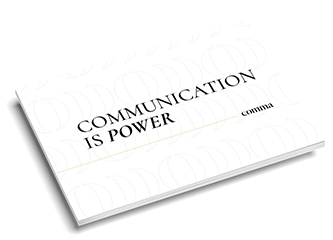Important is not always synonymous with urgent; In fact, sometimes we consultants are so busy and immersed in implementing our strategies, and attending to the day-to-day needs of our clients, that we lose sight of the bigger picture; Our founder often invites us to stop, to make technical stops to breathe, take perspective and, in this way, think critically with the aim of analysing, redirecting or staying the same but with awareness and direction. It feels so good! As a result, this reflection on the challenges for the corporate communication of financial and fintech companies for the year ahead.
Fintech communication: regulated markets and competitiveness
A few weeks ago Silvia Albert summarised for us five of the most important communication challenges in 2023, that are highly applicable to the financial and fintech industry; However, in this industry there is a particularity: it is a regulated market. But it is alsohighly competitive and new actors are arriving daily;
Traditional companies – already operating in the market and already quite intensive with their corporate communication (investment banking, private banking, commercial banking, financial advisory firms, fund managers, insurers…) – are joined by new fintech and insurtech players (neobanks, brokers, roboadvisors, financial technology services, open banking, brokers, digital asset companies, data aggregators, savings solutions, etc.), who are eager to present their brands, business models and (supposedly) disruptions..) who are eager to showcase their brands, business models and (supposed) disruptions; The attention cake is getting smaller and smaller , but there are more guests competing to be the most handsome of the party and get the biggest slice.
The need to create content;
We have detected that almost all of them have in common a limiting bias: they place much of their expectations for results on rapid and massive media coverage even though much of their content is not newsworthy. For many of these firms, communication is limited solely and exclusively to appearing in the salmon newspaper of reference because they have the unrealistic belief that this will have a direct impact on increasing their sales; They take the part for the whole and on the way they miss out on the other powers that communication can bring within their reach;
To highlight: the possibility of finding that story (corporate and differentiating and building stable relationshipswith all their audiences, and then provide them with content on all the channels available to them, without forgetting the ability to devise creative campaigns in collaboration with their audiences. Media coverage should be a consequence, not a cause..
Fintech communication: beyond being in the media
We meet numerous actors navigating a challenging environment: volatility, inflation, difficulty in managing and achieving returns, distrust of society, difficulty in reaching new customers and not suffering losses from current ones, securing funding, changing regulation, budget reductions, valuation issues, corporate moves…. However, firms continue to focus their communication efforts on positive media coverage at a time when media has less and less space The new report also highlights the need to devote more time to news generated by these firms (due to reduced investment in advertising, falling readership, etc.) and increasingly tight newsrooms, where journalists can hardly cope with covering all the actions and information that are produced daily in the industry; Moreover, good journalists distinguish, and do so well, between the wheat and the chaff; One thing is news and another is to advertise the benefits of your “pioneering” “disruptive” solution that comes to “democratise” “make accessible” thanks to technology… and blah, blah, blah.
We see the need for a technical stop of management and communication teams in the financial industry to do some self-analysis, to be realistic and to think: Don’t you see how unfocused we are focusing our communication strategies only on “getting in the media”, shouldn’t we, as experts in our fields, contribute to transparency and bring our knowledge and vision to the society?
Here are some tips to take into account when designing corporate communication strategies for financial institutions and fintechs this year;
10 keys to communication for financial institutions and fintechs
1.- Without the organisation’s commitment to communication, there will be no paradise
Communication should be a strategic asset in organisations and have its place in the management committee of companies; If the communication team works closely with the strategy and business team, the foundations of the story can be better established and, from there, adapted to the different channels in which the organisation connects with its audiences: employees, customers, prospectssuppliers, journalists, investment influencers… As we have explained, differentiation is becoming more difficult than ever; therefore, we will have to be creative, but also consistent and rigorous; There are no shortcuts; it all starts with a commitment that we must pass on to the whole organisation, and by having and knowing how to count on the raw material: the organisation’s intelligence; Even if we experts have open relations with the public, make no mistake: it requires a direct involvement of the management team and key designated spokespersons. Yes, yes, it takes time and resources;
2.- Holistic, personalised and beyond media strategy
Companies are advised to take a long-term approach to their strategies, though the action plan changes often based on the results, the needs of the environment and how current events move. Let us not forget that our competitors are also launching their own actions; Getting media coverage will be a consequence of the activity, campaigns and content we are able to generate together, as long as it is newsworthy for the different media audiences; It is not new that it is essential to coordinate with all areas and experts of the company as in an orchestra..
Setting that common goal and harnessing all the organisation’s resources is essential; Again, each company will have different priorities this year and will have to adapt its strategy to them; More traditional financial firms, such as fund managers, have a lot of room for improvement and many opportunities to communicate through other channels such as their websites, newsletters, podcast, digital channels…. Recently a well-known financial journalist claimed that his biggest competitor was not the media but LinkedIn; For fund managers, an appropriate strategy will allow them to segment their messages in order to meet the different requirements of their regulation; Therefore, it should make us think that it is not just about being;
It is curious how many fintechs, even though they dominate digital channels, are not able to access the intelligence of their employees to produce content that truly contributes and, therefore, is newsworthy; Moreover, their spokespersons are often under-prepared and this shows (as well as producing disastrous results). It could certainly be the medium for B2B communication in 2023 but managed in a professional and truly useful way;
3.- It all starts with knowing yourself (and knowing what others think of you)
Who are you? Who would you like to be? Does what you are saying you are match what your audiences – employees, customers, suppliers, competitors – perceive you to be? What are the dynamics of the conversation? What territories do your competitors embrace? Do you know exactly what information your audiences are looking for? My grandmother used to say: to communicate well, you should listen before you speak;
To have a strategic positioning map® communication and sectoral listening are the tools we use in comma to define our content territories and, in this way, correctly adjust the communication strategy to that reality and not to mere intuition or unrealistic expectations;
4.- In communication, the story must be the umbrella of the strategy
The cornerstone of the communication strategy of any company, entity or brand is to extract that corporate story from which everything will start: the background; From there, side stories will emerge and we will descend into the different channels in various formats: the form;
Thus, the story must be the thread that connects organisations with their audiences and it will advance with the business and with the evolution of the ecosystem in which we operate;
But to have a consistent narrative it is necessary to work directly with the management of companies which, in many cases, are being created on the fly; In organisations with a longer track record, you have to be willing to break the script; Having an expert team to look after your multichannel and transmedia storytelling is more essential than ever; In the fintech universe it is very common to start a business model and then have to change mid-game; The challenge is not to lose the thread of the story;
5.- Let’s accept the crisis as the natural environment in which we operate (or live) and anticipate it!
The dot coms, the 2008 financial crisis, bird flu, preferential shares, stamps, the pandemic, wars, crypto-winter… Although the alarm bells are often sounded well in advance, a lack of listening, perspective or self-criticism can catch you off guard and you end up managing the emergency exit in a very unprofessional manner;
Companies operating in the financial system always face a challenging environment; indeed, many of them owe their existence to it (asset managers); Low yields, rising interest rates, inflation, problems of access to finance, mergers, takeovers… So, you have to stop and think: what could happen in scenario A, B, C… with your business? And get ready;
But crises are not only caused by negative issues; Sometimes they are also caused by inordinate and incoherent growth that leads to duplication of tasks, functions and positions at times when, in the case of fintechs, they move from start ups to unicorns or scale up and face the challenge of maintaining the corporate narrative to an internal audience; In such cases, internal communication becomes a priority, as employees will be the first brand ambassadors and potential new spokespersons;
6.- Machines and people, the equation of success
I’m sorry but yes, many of our functions will be replaced by technology (in some of them, by the way, welcome! clippings, reporting bye,bye). In communication they will also come to take (part) of the work away from us; Don’t panic! Marc Vidal has been saying for some time that “people urgently need to be trained to work with machines”. Who will dominate whom? We’ll see; it’ll make for a Netflix series;
What is clear is that those of us who are experts in communication we will have to learn new skills and processes to apply technological innovations to our function, to optimise processes, to scale, to become more efficient and to multiply our innate capabilities. Everything is going very fast: blockchain, web3, AI, etc. We should not be afraid of the machine learning. What should scare us is that we consultants, journalists, writers, creators… in short, humans, abandon continuous learning as a way of life. Creativity, critical thinking, asking questions, telling stories and connecting dots, people, ideas, businesses… is what we need to master. This year we will test hundreds of technologies, some of which we will take on; some of which we will not; Many changes, new spaces, new professions are on the horizon; As with the first, second or third industrial revolution; If it’s really just the eternal return, sit tight and carry on;
7.- Beware of the new regulation
This is nothing new, the financial and fintech sector, as we said, is one of the most regulated sectors in existence; It is true that nowadays innovation is so fast that we are sometimes out of step; And that, by protecting, we sometimes achieve the opposite. In any case, we will take new regulations and requirements into account in our strategies; This is why it is essential to collaborate with our colleagues in the legal departments and compliance.
We also believe that both the asset management and digital asset sectors require a review of their conversation; It is one thing to comply with red lines, but it is quite another to be misunderstood; In this sense, the approach to a clear communication that Prodigioso Volcán has launched and with which we collaborate from comma, is a huge opportunity. Sometimes we will have to approach legislators or society to explain our innovations more and better; Different regulations around digital assets, taxonomy, financial and non-financial reporting, etc. are coming;
In any case, we will be able to innovate on them in both form and substance; There are many medium-sized companies entering secondary markets and they will have to adapt their communication; Here again, a new variable comes into play: communication with your investors; In addition, SMEs will have to produce their non-financial reports and these can become not only a powerful loudspeaker for the brand, but also a sign of identity, innovation and contribution to society;
8.- Communication with ESG criteria
Applyenvironmental, sustainability and governance criteria not only in your organization, but also in your communication. words create realities. Your messages have an impact; Are we aware of this? It is not about strutting around with greenwashing messages but about being an organisation with clear EGS criteria that is also reflected in your communication;
How do you communicate with your employees, with your suppliers? How do you make your corporate presentations and your events? Do you print without any rhyme or reason and produce things that you throw away? Do you give away objects manufactured without sustainable criteria? Are you transparent? Do you have clear criteria for corporate governance? How do you treat your collaborators/consultants/suppliers? How do you interact with journalists when they ask you about something you don’t want to talk about? What impact do your messages have on the conversation in the sector, in society? What are your ethical criteria? Do you know your biases?
How far are you willing to go to achieve the longed-for virality? Recall the Mundo Crypto communication campaign, which by the way is now on the brink of bankruptcy. It is important to be clear that communication does not work miracles; It should simply be consistent with who you are; Don’t be obsessed with telling things you don’t do, things you are not, things you don’t think; Do first; then communicate;
9.- KPIS vs. expectations
A huge obstacle we will continue to encounter this year is obsessing over KPIs without aligning them with what the customer expects to receive; Let’s not forget that communication is about intangibles and, even though these can certainly be assessed, follow other criteria than those of, for example, marketing; To avoid disappointment, it is important to define the firm’s expectations and the criteria for measuring the results of the strategy from the outset; Sometimes it is better not to not work on a project than to force it if the firm expects results that will never be achieved; It burns the firm and burns the team; Moreover, it is not sustainable over time; Intangibles such as reputation and notoriety are difficult to measure; They are certainly not measured by the weight of the cover (which, by the way, can now be bought very easily); We need to be creative and establish different indicators; and even go one step further: could we measure, for example, the impact of our voice on the conversation in the industry in which we operate?
10.- Creativity and collaboration for solutions to common causes
Stop navel-gazing and come up with collaborative creative campaigns that provide solutions to common causes; May this be the year when we understand that there is room for everyone and that there are causes worth embracing together; Since we started working in financial communication, all actors talk about the need to increase trust in their work, improve financial education, democratise investment… Only the union of different companies in the sector in a common objective to create communication campaigns that change realities, shake up and cause a positive impact related to the financial and technological world can be the solution to common causes; Continuing to work on our own territories, each one separately, sounds more like opportunistic initiatives than a clear vocation to change perception, knowledge and improve the performance of all; Can you work for a cause even with your competitors? Creativity is connecting the dots;
As Heraclitus said: “Nothing is permanent except change”; The same goes for our strategies; What works this year may not work the next; If the business objectives or the sector move, so do our action plans; we have to be aligned, anticipate, be coherent, agile and flexible; Hence the importance of surrounding yourself with communication experts who live in continuous learning, who are not afraid to collaborate with machines and even with your competitors for the common good; A multidisciplinary team, with passion and ambition, able to inspire, advise and be proactive in helping you to navigate resiliently and adapt your story to a changing, challenging and very exciting environment; How does it sound?






